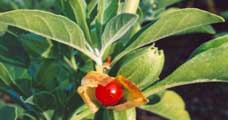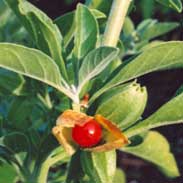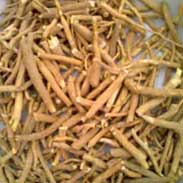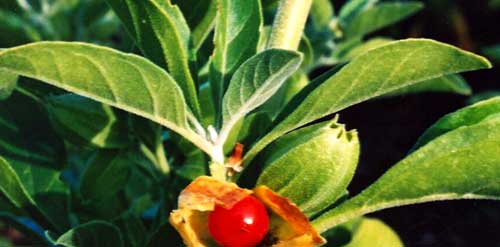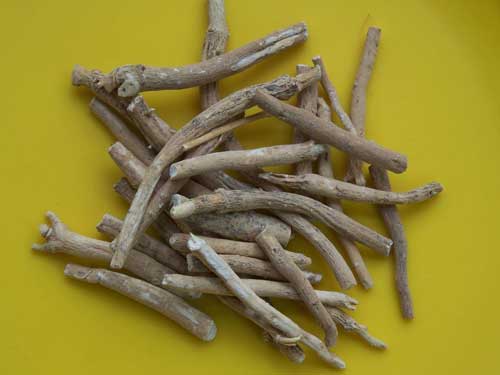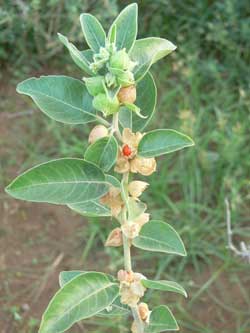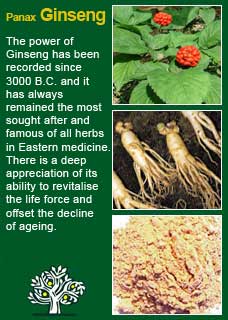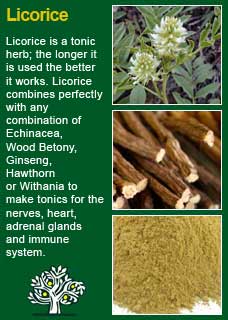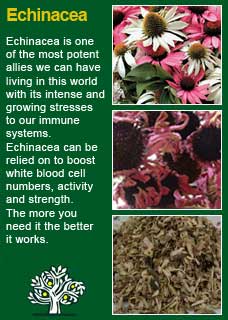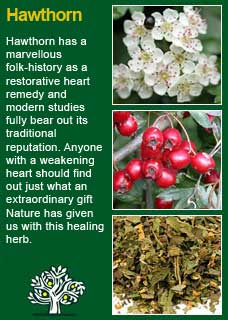
|
|
||||
| Our Pages ABOUT CONSTITUTIONAL MEDICINE
|
In herbal medicine we use the roots of Withania, a small shrub that grows from 30-70cms tall in hot, dry places in the world, especially in India where it is one of the most widely used and revered of all traditional Ayurvedic herbs.
It is commonly said that Withania is the single most important herb in Ayurvedic medicine (the chief medicine of India), itself a system with written records that go back thousands of years and an oral history that goes back at least 5000 years. Withania has had so many traditional uses that, like any true tonic, it is very hard to briefly summarise, but it would be an injustice to this great herb not to give at least something of a list of its traditional uses. The following are the kinds of problems that Withania has been called on to help:
Sharol Tilgner writes 'In India, Ashwagandha (Withania) is thought to instil the vitality of a horse to the consumer. The adaptogenic and tonic effects are best suited to people who are debilitated or exhausted while agitated or under stress. The root is used for nervous exhaustion, stress-induced health conditions, anaemia with emaciation, impotence with aging or due to stress, chronic inflammation depressed white blood cell count due to cytotoxic drugs and cognitive function deficits including those with aging and hypertension' Tilgner recommends doses of a tablespoon of dried root to a cup of water or 1-3 mls of the fluid extract.
~Withania extracts were shown to be better at decreasing baseline biomarkers of inflammation than were standard anti-inflammatory drugs at relative doses (Anbalagan K, Sadique J. Int J Crude Drug Res 1986;24(2):90-100) ~ The authors, titles and the 'where-and-when' published of nearly 90 further studies and articles on Withania are listed in a PDF found here
For some years now, against this proven and safe way of herbalism, there has been a rising tide of excessive caution and scare-mongering in many parts of the world. The same authorities that, not so long ago, decried herbal medicines as ineffectual, have now taken up a different adversarial position; that they are dangerous substances that should only be prescribed by Doctors, who of course have zero training in them. Unfortunately, the same unnecessary fear and worry has crept into many natural health websites and popular publications on herbs. Herbs that we have safely used for thousands of years, that have no reports of adverse reactions in the medical literature despite widespread use by millions of people, are suddenly described as contraindicated because of something that should have been seen as completely unimportant, or at the utmost a merely theoretical concern, such as a laboratory study on one of the herb's constituents to use an all too common example. I wonder sometimes if the writers of such articles feel that the herb will be more deserving of respect if it is thought to be a little bit dangerous, in other words more like a drug than something that has simply come out of the earth and been used by ordinary people for generations beyond count. There is just so much misinformation about herbal medicine on the internet now. Ludicrous claims and cautions abound in equal measure; it seems like one group are trying to make money out of the public whilst the other are busily trying to scare them off. I have to believe that the kind of reader who takes the time to read pages on herbs that are as extensive as this one is much less likely to be swayed by marketers or misinformers. I hope that you will keep your wits about you if you get conflicting opinions from people who have never really got to know these herbs, who have never worked with them, or learned how to use them safely and effectively. I want to remind you that the reason that herbs can never be patented and owned by any individual or corporation is because they are, and always will be, the People's medicine. They belong to all of us and it is my great hope in sharing this work that you will learn how to use them wisely for yourself, and the people you care for. Be safe, but do not be afraid.
Withania somnifera, like Ginseng, is a rather humble looking shrub but what goes on in those roots has a remarkably complex personality. Withania sings you a lullaby when you first start getting to know it. People sleep better, they feel less irritable and it takes more to get them upset. I notice that people look a little younger after a short while of taking Withania and I guess this is because they are frowning less and smiling more! What happens after a while (usually about a week, maybe two) is then that Withania starts waking you up! This is where the increased sexual energy may start to come in and people feel like doing more in general. I hear people say things like they feel more motivated and have been getting more things done. This is a sign of a true tonic effect, first it relaxes you, then it turns around and starts energising you. I think that this is why I find it so helpful in clinical practice where many of my patients have been ill for a long time. The increased sleep and relaxation that Withania generates moves the healing process forward, then the tonic effects kick in and as they start doing more exercise or just moving more in general they start accumulating savings in their 'energy bank' rather than getting further depleted. Children do well on Withania, they eat more and get noticeably stronger and more resilient if they keep it up for a good while. People in their 60s, 70s, 80s and beyond also do very well on Withania and, so long as they keep taking it for long enough, you see a consistent renewal of vitality and improved health. That said, the majority of the people I have given Withania to have been working adults and, for many, Withania can be the key ingredient to getting de-stressed and having more energy. In many cases, I could no more imagine treating people's tiredness without Withania than I could treat immune problems without Echinacea. On a related note, I think it is the single most important herb to help a person with a low thyroid function. The improving numbers (from lab tests) speak for themselves when you use plenty of Withania to help; because it obviously works. If you who are reading this are studying herbal medicine or if you have your own good reasons for wanting to understand this great plant ally at a much deeper level then I warmly encourage you to take a good dose of Withania tea or tincture and then, with a quiet and attentive mind, observe for yourself how it makes you feel. This ancient method of 'experiential' learning can help you to get a personal grasp of the 'action' of the herb in a way that academic study can only point towards. Speaking for myself but also having done this experiment with many students and colleagues, I can say that the energy of this humble looking but potent herb can usually be felt right down at the very core - in one's bone-marrow you might say; it truly is quite a remarkable tonic, but I think you will have to try this for yourself to see what I mean... Further to this, if you would like to learn more about the ancient art of pulse testing, a simple but powerful way to ask the intuitive intelligence of the body for its responses to a herb by feeling the pulse whilst giving a tiny dose by mouth, read here I don't think there is one right dose of Withania that is right for everyone, but I do think that this this is a herb that can be used in large amounts to get a rapid effect on anxiety, insomnia or fatigue and I recommend the traditional method described below to get a big dose quickly when needed. I use a great deal of the Withania extract that we make in our clinic from raw, organic herb. Doses of this range anywhere from about 2 to 8mls in a day. For longer term use I give a lot of capsules of Withania and Panax Ginseng. We supply the raw herb (so I know it is the right stuff) and we get the encapsulating done by a local company and people usually take around 4 of these capsules a day, The thing with Withania is that you need enough of it for the steroidal saponins and other beneficial constituents in it to work, but once it is having an effect you won't necessarily get more benefit by taking larger amounts. The way to get the most from it is to simply use it patiently and for as long as you need its support. Withania combines perfectly with Panax Ginseng and Licorice root for fatigue or exhaustion, with Echinacea for a depressed immune system and with Hawthorn for a lack of physical vitality and heart strength.
Take 1 heaped dessertspoon of cut Withania root and place in a small saucepan with about 1 ½ cups of milk (or a combination of milk and water). Add at least one tsp or more of raw sugar (or honey) to taste and also add a small sprinkle of black pepper. You might like to try adding a small amount of Cinnamon powder as well. Bring this mixture to just about boiling and then keep stirring on a gentle simmer for several minutes or until nearly half a cup has been absorbed into the root or evaporated. Take off the heat, strain into a cup, and drink. Most people find the taste of this old traditional Withania drink more than acceptable and many say they actually find it quite delicious, especially after they have had it a few times. You can see people visibly relaxing and smiling more by the time they finish drinking this, it is ' feel-good' medicine Much of the information here about the traditional uses of Withania is consistent with the model of thinking whereby one may treat problem A with plant B. There is value in this approach in how it helps us pass on useful knowledge to one another but where it falls short is that people are not all cut from the same cloth! Withania might work brilliantly for one person but less well for another with the same kind of symptom picture -- why is this? Part of the reason is that people vary in their constitutions as to whether they are either hotter or cooler and, at the same time, either dryer or damper. This useful and rather fascinating subject is introduced further here Another big part of using the right herb when it is most needed comes from understanding the need to treat what is going wrong for the person that had led up to their getting a health condition. In this light, Withania can particularly offer its benefits when a nourishing action is needed in the 'cycle of healing', more about this here
Please understand that I cannot advise you, including on products or dosage, without seeing you in person in my clinic but for ideas
on how you might find a good herbalist in your area read here |
|
|
|
© 2011 R.J.Whelan Ltd
